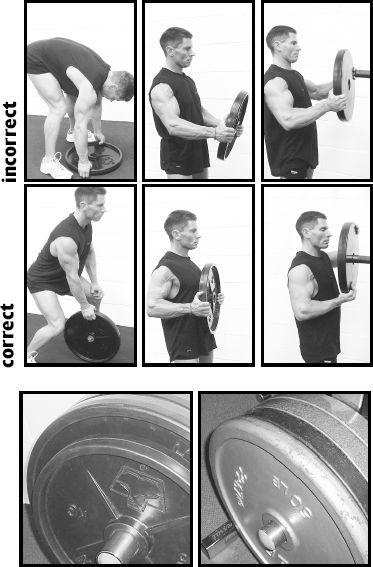
Correct lifting technique isn’t restricted to exercises. It’s also needed while setting up an exercise, or putting equipment away. Many trainees have been injured through improper weight handling between exercises.
Plate handling
With a large plate, carry it by itself in two hands, held tightly to your abdomen or chest. When putting the plate on a bar, plate stand, or rack, or when taking it from a bar, plate stand, or rack, get as close as possible, feet side-by-side, plate close to and centered on your torso, head up, shoulders pulled back, and your lower back slightly hollowed. Never round your shoulders as you handle any load.
If you return a heavy plate to a plate stand using one hand only—perhaps in a confined place—keep the plate close to you, and brace your other hand on the stand.
Don’t carry two or more stacked plates. When carrying two plates, hold one in each hand, for symmetrical distribution of load. Never struggle with multiple large plates—carry them one at a time. The additional time you need to make multiple visits to a bar, stand, or rack is a small price to pay for safety.
If there’s a selection of plates, choose those that have a deep, outer ridge or lip. That construction is easier to hold than that of smooth-sided plates, or ones with only a shallow outer ridge.
If you ever drop a plate, immediately get your feet out of the way. Feet have been broken by dropped plates.
Barbell handling
Strip a bar of any plates, before moving it. The bar may, however, be a fixed-weight one, which you can’t strip down. The heavier the weight, the greater the care required. But even light weights need care. When taking a bar from or returning it to stands, or anywhere else, keep it close to your body, get your feet as close as possible to it, bend at your knees, keep your head up, and lower back slightly hollowed.
Dumbbell handling
When lifting dumbbells from a rack, get as close as possible to them. Bend your knees, keep your head up, and your lower back slightly hollowed. Lift two dumbbells simultaneously and symmetrically, or one at a time (with both hands on the handle) but symmetrically. With two dumbbells, the load will be symmetrical provided the ‘bells are lifted at the same time, your feet are side-by-side, and the weights are equidistant from your midline. If one foot is in front of the other, for example, stress will be applied asymmetrically, and the risk of injury will be increased.
An alternative way of handling a single dumbbell is to get close to the rack, with knees bent and lower back slightly hollowed, grab the dumbbell with one hand, and brace the other hand on the rack or another dumbbell. As you lift the dumbbell, simultaneously push hard with your bracing hand, to maintain symmetrical distribution of stress. Once you’re standing, hold the dumbbell symmetrically in front of your thighs, with both hands, and then carry it to position. Return for the second dumbbell, if required.
When taking a dumbbell off the floor, take special care. This involves a greater range of motion than taking the weight from an elevated surface, and easily leads to rounding of the back. With your feet side-by-side about shoulder-width apart, and astride the dumbbell, bend at your knees, keep your head up, and your lower back slightly hollowed. Grab the dumbbell with your left hand, for example, and place your right hand on your right thigh. As you lift the dumbbell, simultaneously push hard with your right hand, for symmetrical distribution of stress. Once you’re standing, hold the dumbbell symmetrically in front of your thighs, with both hands, and then carry it away. Return for the second dumbbell, if required.
Between sets, to reduce dumbbell handling awkwardness, set the ‘bells on a bench, box, or other elevated surface, rather than the floor.

Weight plates with a deep, outer ridge, or lip (left), permit easier handling than plates with a shallow outer ridge (right).

Plate handling on a loading pin
The hip-belt squat, pinch-grip lifting, and wrist roller require the use of a loading pin.
The longer the loading pin, the more space there is for stacking plates. When plates of the same size are loaded consecutively, especially large ones, it’s easy to trap your fingers, and tricky to remove the plates. To make loading safer and easier, place a small plate between each pair of large plates. This will, however, use up more of the loading pin than would stacking the same number of large plates directly on top of each other, and thus a taller loading pin may be required sooner. For the hip-belt squat, taller platforms may be required for standing on, to compensate for a taller loading pin, so that the range of motion of the exercise isn’t reduced.
Respect your limitations
Don’t try to lift something you know is beyond you. Get help.

A loading pin with one 15-kilo and four 20-kilo plates stacked on it, with a single 1-1/4 kilo plate between each pair of large plates, to produce a gap between the big discs. See text. The loading pin here is attached to a carabiner, which in turn is attached to the front strap of an IronMind® Enterprises’ hip belt.